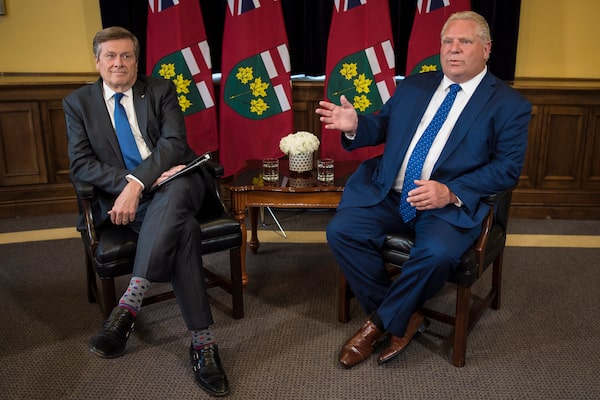
Toronto Mayor John Tory, left, and Ontario Premier Doug Ford meet inside the Premier’s office at Queen’s Park in Toronto on July 9.Tijana Martin/The Canadian Press
Ontario Premier Doug Ford’s sudden decision to rewrite the rules for an election already under way has thrown some of the province’s most closely watched races into turmoil, and touched off a flurry of last-minute, high-profile additions to the mayoral races in two of Canada’s largest cities.
Mr. Ford announced on Friday that he would make changes to existing municipal and regional election rules, cutting the number of city-council positions in Toronto nearly in half, and cancelling races for regional board chairs. The proposal was condemned by opponents as “undemocratic,” and a “back-room plot,” and left shell-shocked city officials wondering whether new ballots can be printed in time for the October elections.
Within hours of the announcement, two new candidates entered Toronto-area mayoral races: ousted Progressive Conservative leader Patrick Brown in Brampton, and former chief planner Jennifer Keesmaat in Toronto.
Mr. Ford said on Friday his proposed changes, which must be approved in a vote in the Legislature, are meant to “dramatically improve the decision-making process” for local governments. Mr. Ford was a Toronto councillor from 2010 until 2014, and said that during his term, he witnessed the gridlock caused by a large local government. His plan would reduce city council seats to 25 from 47, with the newly drawn wards to mirror provincial and federal electoral boundaries. The plan, he said, could save the province up to $25-million over four years.
Friday’s announcement set off a level of turbulence at Toronto’s City Hall not seen since Mr. Ford’s tumultuous time on council, when he served alongside his late brother, then-mayor Rob Ford.
Registrations for the election opened in May, and many candidates had begun fundraising and door-knocking.
On Friday morning, the usually sedate Mayor John Tory, who told reporters he learned details of the decision from media reports the night before, and had a “lengthy and animated” conversation with Mr. Ford.
“You don’t change the rules in the middle of the game. That’s not right and that’s not fair,” he said in a news conference on Friday. “Mr. Ford promised to be a government for the people. Be true to your words. If you are truly a government for the people, let them decide.” He’s asked the province to delay the change and have a referendum on it.
And while a number of councillors – many of them from suburban wards or former allies of Mr. Ford – supported the Premier’s plan on Friday, others accused him of using his new role to settle grudges against them for previous clashes.
“This is Doug Ford taking revenge out on Toronto and just throwing a stick of dynamite at council and saying: Figure it out,” long-time councillor Joe Mihevc said. Under the proposal, many incumbent councillors would be pitted against one another, a move Mr. Mihevc described as an attempt to rid the city of progressive politicians.
“This is not about thoughtful decision making.”
Councillor Kristyn Wong-Tam called the Premier’s proposal “extremely anti-democratic,” and “an affront to our democracy.”
By Friday afternoon, the news appeared to motivate at least one new entrant into the mayoral race – the first real challenger to Mr. Tory since he registered in May.
Less than an hour before the 2 p.m. deadline, Ms. Keesmaat, the high-profile former City of Toronto chief planner, arrived at City Hall to register her run for mayor.
Ms. Keesmaat did not answer directly when asked whether the provincial plan had prompted her to run. But she acknowledged it was a last-minute choice.
“It was a very impromptu decision, but one that comes deeply from my heart and passion for this city,” said Ms. Keesmaat, who as planner was sometimes criticized for straying into politicking.
“I believe that we need strong leadership, and a strong city council, in order to continue to deliver. In changing times, we need changing leadership.”
Hundreds of protesters descended on City Hall in the afternoon, filling the council chamber to capacity and chanting “shame, shame, shame” as a debate over Mr. Ford’s plan wrapped up inconclusively, to resume on Monday.
The effects of the Premier’s announcement reverberated far beyond Toronto, particularly the decision to cancel elections for the regional positions in Peel, York, Niagara and Muskoka. The proposal would reverse the decision to fill the positions by election rather than appointment, as was done in the past.
Mr. Brown had been registered to run for the Peel chair. But by Friday afternoon, he decided to enter the race for mayor in Brampton.
Mr. Brown was ousted as PC leader after a CTV News report on sexual-misconduct allegations against him. Mr. Brown denies the allegations and has launched legal action against the network.
Mr. Brown said he was “shocked” by the plan to change municipal governance mid-campaign without consultations.
“You can’t look backwards, you can only look forwards," he said. “I want to make sure Peel Region is treated properly. I want to make sure we create prosperity in Peel Region and in Brampton, and so that’s my task now.”
Mr. Brown, who has represented ridings in Barrie federally and provincially, told The Globe and Mail last month that he moved to a rented home in Mississauga with his fiancée a few months ago. The address he provided when he registered to run for chair of Peel Region earlier this month was a sprawling house on Mississauga’s waterfront.
On Friday, Mr. Brown said the couple have also been renting a house in Brampton, and that after deciding to enter the Brampton mayoral race, he made that his principal residence, as is required to run.
Brampton Mayor Linda Jeffrey – who is seeking re-election – tweeted that she welcomed Mr. Brown’s entry, but added “that the ink barely dried on his lease before he decided to seek our city’s highest office.”
While many called the Premier’s announcement “unprecedented,” John Mascarin, a municipal lawyer, said the proposal is within the Premier’s authority.
“The province has the constitutional authority to change the rules,” he said. “They can create municipalities, they can change municipalities, and they can do away with municipalities.”
He cited as an example the provincial government’s decision under premier Mike Harris in the mid-1990s to amalgamate the City of Toronto against fierce opposition.
Still, he questioned the timing of the proposal, and the manner in which it was announced – in a campaign period, and on the cut-off date for registering to run. That deadline will be pushed back to September.
“While I said that the province has the authority to do it, I think the question is going to be: ‘Are they doing it correctly?’"
On Friday evening, a weary-looking Ulli Watkiss, Toronto’s city clerk, who administers city elections, answered questions in the council chamber from councillors about the proposal.
She cited a long list of preparations that would need to be re-done, from testing equipment to printing ballots to revising voting locations. Vote tabulators would have to be re-calibrated, she explained, which may not be done in time. And if necessary, clerks might have count by hand.
“We cannot run an election with a nomination [period] that ends on Sept. 14 and be ready to have an advance vote on Oct. 6,” she told them. “I can’t even print ballots in three weeks.”

Ford plans to cut the number of city councillors
from 47 to 25
How Toronto's new structure stacks up against
other Canadian cities
APPROXIMATE POPULATION PER COUNCILLOR
Toronto (25 councillors)
109,000
Toronto (47 councillors)
58,000
Calgary (14 councillors)
86,000
Edmonton (12 councillors)
78,000
Vancouver (10 councillors)
63,000
Winnipeg (15 councillors)
47,000
Ottawa (23 councillors)
41,000
Montreal (46 councillors*)
37,000
Hamilton (15 councillors)
36,000
Halifax (16 councillors)
25,000
Saskatoon (10 councillors)
25,000
Note: Mayors not included
*Montreal has an additional 18 borough mayors that sit
on city council. The 46 councillors represent districts
within these boroughs. There is a total of 64 elected
officials in Montreal’s city council, excluding the mayor.
TRISH McALASTER / THE GLOBE AND MAIL
SOURCE: CITY WEBSITES, POPULATION DATA
IS FROM 2016 CENSUS

Ford plans to cut the number of city councillors from 47 to 25
How Toronto's new structure stacks up against
other Canadian cities
APPROXIMATE POPULATION PER COUNCILLOR
Toronto (25 councillors)
109,000
Toronto (47 councillors)
58,000
Calgary (14 councillors)
86,000
Edmonton (12 councillors)
78,000
Vancouver (10 councillors)
63,000
Winnipeg (15 councillors)
47,000
Ottawa (23 councillors)
41,000
Montreal (46 councillors*)
37,000
Hamilton (15 councillors)
36,000
Halifax (16 councillors)
25,000
Saskatoon (10 councillors)
25,000
Note: Mayors not included
*Montreal has an additional 18 borough mayors that sit on city
council. The 46 councillors represent districts within these boroughs.
There is a total of 64 elected officials in Montreal’s city council,
excluding the mayor.
TRISH McALASTER / THE GLOBE AND MAIL
SOURCE: CITY WEBSITES, POPULATION DATA
IS FROM 2016 CENSUS

Ford plans to cut the number of city councillors from 47 to 25
How Toronto's new structure stacks up against
other Canadian cities
APPROXIMATE POPULATION PER COUNCILLOR
Toronto (25 councillors)
109,000
Toronto (47 councillors)
58,000
Calgary (14 councillors)
86,000
Edmonton (12 councillors)
78,000
Vancouver (10 councillors)
63,000
Winnipeg (15 councillors)
47,000
Ottawa (23 councillors)
41,000
Montreal (46 councillors*)
37,000
Hamilton (15 councillors)
36,000
Halifax (16 councillors)
25,000
Saskatoon (10 councillors)
25,000
Note: Mayors not included
*Montreal has an additional 18 borough mayors that sit on city council.
The 46 councillors represent districts within these boroughs. There is a total
of 64 elected officials in Montreal’s city council, excluding the mayor.
TRISH McALASTER / THE GLOBE AND MAIL
SOURCE: CITY WEBSITES, POPULATION DATA IS FROM 2016 CENSUS
 Ann Hui
Ann Hui Oliver Moore
Oliver Moore Jill Mahoney
Jill Mahoney